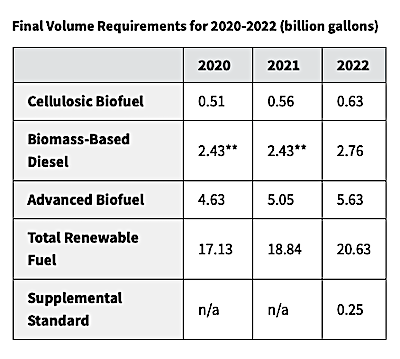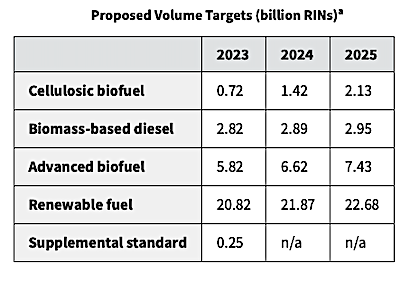The New RVOs, Not as Clear Cut as it Might Appear
 By Bradley Schad, CEO, Missouri Corn Growers Association
By Bradley Schad, CEO, Missouri Corn Growers Association
Special to The Digest
The release of the proposed rule by the U.S. Environmental Protection Agency to set volume obligations for the RFS was, on the surface, a positive development. The conventional biofuel category, which is the domain of corn ethanol, would require 15 billion gallons next year, with a slight increase over the next two years.


The advanced category, which includes diesel and cellulosic biofuels, totals 5.82 billion gallons for a grand renewable fuel total of 20.82. Over the three years, it represents a 10, 11.9, and 12.5 percent market share of transportation fuels. For many who have been pushing the renewable fuel rock up the hill for decades, this isn’t bad.
Looking closer
A couple of things warrant a closer look, however, and this percentage issue is important to understand and why we simply must demolish the blend wall. In 2021, the total finished gasoline consumption in the U.S. was 134 billion gallons. That is finished gasoline, meaning the roughly 15 billion gallons of ethanol we use is in that total. Looked at another way, that means the available pool to blend is about 120 billion gallons. Ten percent of that is 12 billion gallons of ethanol. Calling for 15 billion is justified thanks to seasonal E15 and E85, plus there are extra RINS out there to turn in. Always keep in mind the RFS isn’t gauged by wet gallons but by RINS, which I’ll get to.
But what do we do as the pool shrinks, as it most certainly will due to EVs and increased efficiency requirements? In a few years, if it is 100 billion gallons or less to blend into, 15 billion gallons would be 15%, not 10, and would have to assume that E15 is the base gasoline in the U.S. While that is certainly possible, it is not likely that every single gallon would be E15.
To maintain the equivalent market share we have now, under the 100- billion-gallon pool scenario, even if we can make E15 the base gasoline for the entire country, is that where we want to stop? As corn growers with a multifaceted feedstock that can feed and fuel the world, we want to see ethanol production volumes grow, and the only way that will happen is if blend volumes increase.
The Next Generation Fuels Act
EPA could only be persuaded to keep volume limits high if there were no obstacles to higher blends, and the demand for clean octane ethanol was in place. Fortunately, we have an answer for that—the Next Generation Fuels Act. We say goodbye to Rep. Cheri Bustos of Illinois, who retired but left us with a terrific piece of legislation to continue the fight. That bill would increase octane levels, require automobiles to over time be warranted up to 30% blends, control toxic aromatic compounds currently used for octane, ensure replacement octane additives to meet a 40% GHG reduction, require use of the GREET Model, provide the RVP waiver for any blend, and address other issues.
So if we are going to dream, let’s dream big. Even in a shrinking pool of 100 billion gallons of gasoline, a 98+ octane made with E30 blends would create demand for 30 billion gallons of ethanol!
What this tells us is that without this legislation—and we recognize the RVP issue may be resolved with its own legislation—the ethanol industry cannot allow itself to be limited by what an RFS calls for. If the pool drops to a really low level, like 75 billion gallons, even a total E15 base would need only 11.2 billion gallons of ethanol!
But it could get worse—a lot worse, and here’s why. Renewable and biodiesel are issued RINS with a multiplier. RD, for example, gets 1.7 RINS. With announced capacity for RD at volumes as high as 5 billion gallons, it would generate 8.5 billion RINS. All those “extra” RINS refiners own could be turned in rather than buying ethanol, further reducing demand under the RFS. The same goes for cellulosic and E RINS—there are a number of scenarios that could send us backward in terms of corn grind and actual gallons.
The perplexing Regulatory Impact Analysis
And worse yet is the perplexing Regulatory Impact Analysis (RIA) that accompanied the rule. This analysis claims the RFS, specifically the road transport category, increases every pollutant from NOx to evaporative emissions—even carbon monoxide!
Could that be used in future years to backtrack on RFS volumes and further erode demand? Quite possibly, certainly ethanol opponents could point to that and challenge any use of ethanol, never mind an increase. How could this be? The answer is the MOVES model EPA uses that penalizes ethanol and must be corrected.
So we have our work cut out for us, even if the current proposed RVOs are finalized. The Next Generation Fuels Act, the control of toxics in gasoline, the correction of the MOVES Model, and demanding EPA correct this flawed impact analysis are on the to-do list.
Bradley Schad serves as the chief executive officer of the Missouri Corn Growers Association (MCGA) and the Missouri Corn Merchandising Council (MCMC). Bradley began his involvement with the organizations in 2008, managing programs focused on ethanol and other market opportunities.
Category: Thought Leadership, Top Stories















